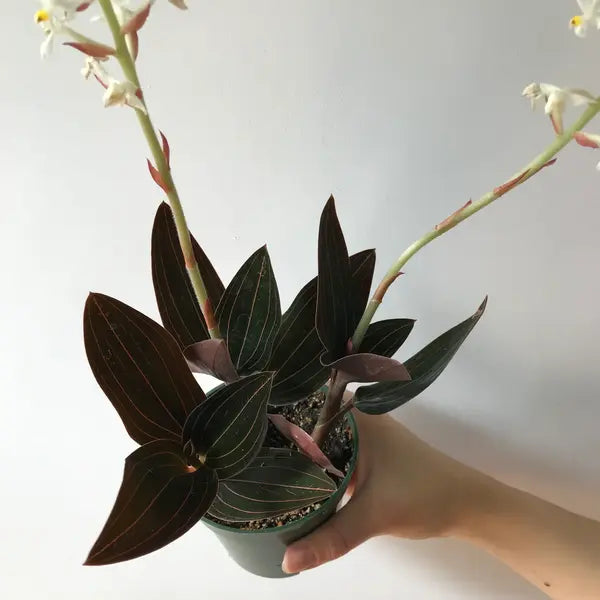
Ludisia Discolor Opportunist Var Nigricans Black - Rare
Selling Size : Single Plant | Pot Included | Secure Packing
Ludisia discolor var. nigricans, also known as the Black Jewel Orchid, is a terrestrial orchid prized for its stunning, velvety, dark foliage with a striking central stripe. While it's an orchid, its care is more similar to that of a typical houseplant.
Here is a guide to its care for a Ludisia Discolor Opportunist Var Nigricans Black :
Light
Bright, indirect light is ideal. This plant thrives in bright, dappled shade.
Avoid direct sunlight. Direct sun, especially strong afternoon sun, can scorch the leaves and cause them to turn brown or yellow.
An east or north-facing window is often a perfect location.
Water
Keep the soil consistently moist, but not waterlogged. Jewel orchids are sensitive to both overwatering and underwatering.
Water when the top inch or two of the soil feels dry.
Overwatering can lead to root rot, yellow leaves, and loss of flowers. Underwatering can cause leaves to become dry and shriveled.
If your tap water is hard, consider using distilled or rainwater to avoid mineral buildup.
Humidity
High humidity is key. Jewel orchids are tropical plants and prefer humidity levels of 60% to 80%.
If your home is dry, you can increase humidity by:
Using a humidifier.
Placing the pot on a tray filled with pebbles and water (making sure the bottom of the pot doesn't sit in the water).
Placing it in a terrarium.
Very low humidity can cause the tips of the leaves to darken and flowers to be stunted.
Temperature
Maintain a warm and consistent temperature. The ideal temperature range is between 18°C and 27°C (65°F and 80°F).
Avoid cold temperatures. Temperatures below 10°C (50°F) can cause the plant's leaves to turn yellow and fall off, and in severe cases, kill the plant.
Protect the plant from cold or hot drafts.
Potting Medium
Use a well-draining, moisture-retentive mix. A good mix will allow for air circulation while holding some moisture.
A suitable mix can include components like orchid bark, sphagnum moss, perlite, and a small amount of potting soil.
Fertilizer
Feed sparingly during the growing season. Use a balanced, diluted fertilizer (e.g., at 1/4 strength) every 4-6 weeks in the spring and summer.
Reduce or stop fertilizing in the winter. Over-fertilizing can damage the roots.
Other Tips
Repotting: Repot every 1-2 years or when the plant becomes rootbound. The best time to repot is in the spring.
Pinching: You can pinch the tips of the plant to encourage a bushier growth habit.
Cleaning: Gently wipe the leaves to remove dust and keep them looking shiny and healthy.

